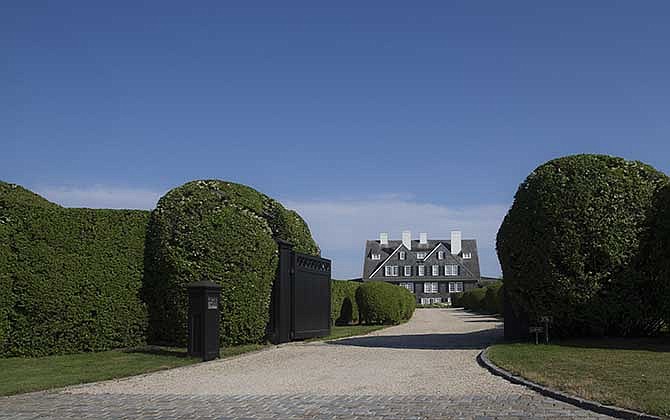SOUTHAMPTON, N.Y. (AP) - This is a town where people are so rich that a $2 million home can be a handyman's special. A town where the thrift shop is stocked with donations of designer dresses and handbags.
But Southampton, with its privet hedges, pristine beaches and some estates costing tens of millions, also is where 40 percent of children get free or reduced school lunches, where a food pantry serves up to 400 clients a month and where some doctors and nurses share homes owned by the local hospital because they can't afford to buy or rent.
Studies show the wealth gap separating the rich from everyone else is widening, and few places in the country illustrate that as starkly as Long Island's Hamptons - America's summer playground for the haves and have-mores, where even middle-class workers struggle with the high cost of living.
"We have a tremendous amount of millionaires who live 3 miles from the food pantry, and they really have no idea that there's a need in this community," said Mary Ann Tupper, who retired last month after 21 years as the executive director of Human Resources of the Hamptons, a charity that assists 6,000 people annually through its food pantry and other services for the working poor.
"In the summer they're working and everything is pretty good, but come the winter, all the nannies, the gardeners, the pool people, all those people are out of work, and then there's no money," Tupper said. "The income disparity is tremendous."
Kerry Lewendoski, who succeeded Tupper, adds: "The people aren't just coming here to work in the summer. They live here; they have established homes and kids enrolled in the schools. Southampton is their home, and they still have trouble getting by."
Located on southeastern Long Island 80 miles from New York City, Southampton is one of several towns and villages stretching east along 40 miles of the Atlantic Ocean that collectively are known as the Hamptons. Census figures showed a 2010 population of 57,000 and a median income of $78,815.
But statistics in the Hamptons are an elusive notion, since many of the summertime denizens with their multimillion-dollar incomes identify themselves as residents of New York City or elsewhere. In the first quarter of 2014, the average selling price for a home in Southampton town was $1,845,431, though some oceanfront estates go for over $100 million.
Celebrities spotted hanging out in the Hamptons include Christie Brinkley, Rachael Ray, Kelly Ripa and Howard Stern, among other members of high society in New York and elsewhere.
Many of those who work in the Hamptons - painters, landscapers teachers, even journalists - live west of the region in suburban Long Island and commute as many as three hours round-trip daily. From early spring to late autumn, the one primary road in and out of the Hamptons is jammed most mornings with pickup trucks and vans filled with tradespeople headed east.
"There's tons of work out here because this is where the money is," David Hahn said while trimming 16-foot hedges on a 10-acre Southampton estate where he has worked for two decades. His 30-mile commute sometimes takes up to three hours round-trip.
Kimberly Piazza is a secretary in her husband's sod business and lives in the North Sea community in Southampton town, several miles north of the oceanfront estates. Coming out of the local general store, she said local milk prices are as high as $5.99 a gallon and eggs sell for up to $4 a dozen - nearly double what those staples cost elsewhere on Long Island. Gasoline prices are 50 cents to a dollar more a gallon at most stations in the Hamptons.
"The image is that we're all pretty much rich, hoity-toity, well-to-do people," she said. "And while you do have some of those people, a majority of us are still working class."
At Southampton Hospital - the region's primary medical facility that has 25,000 emergency room visits annually - administrators wrestled for years with staffing shortages because qualified applicants could not afford the cost of living.
The hospital has since purchased three houses nearby and allows 17 nurses to live there as part of their compensation package, said spokeswoman Marsha Kenny. A similar program exists for resident doctors, with a goal to keep some working full-time at the hospital when they complete their training.
Last month, over the objection of neighbors, the town board unanimously approved a plan to build a 28-unit apartment complex, in part to provide affordable housing for people who work in the area.
"We have teachers and critical care workers that are commuting an hour and a half each way to work," said town supervisor Anna Throne-Holst. "What makes anyone think they're going to make that commute? And if they do, are we really getting the best of the best?"
R. Couri Hay, a Manhattan public relations executive and contributing editor at Hamptons Magazine, said many of the wealthy who summer in the Hamptons are concerned about the year-round workers and participate in many philanthropic events to help local charities.
"All the fancy people paying $1,000 a ticket for a charity fundraiser, they're spending this money to show support for the community," Hay said.
While Hay conceded there is a wealth gap, he suggested some of the service workers reap higher rewards in summer because they charge their clients more.
"The fantasy is that everything in the Hamptons is because of cheap labor. That's simply not true. I wouldn't say most people are underpaid."

